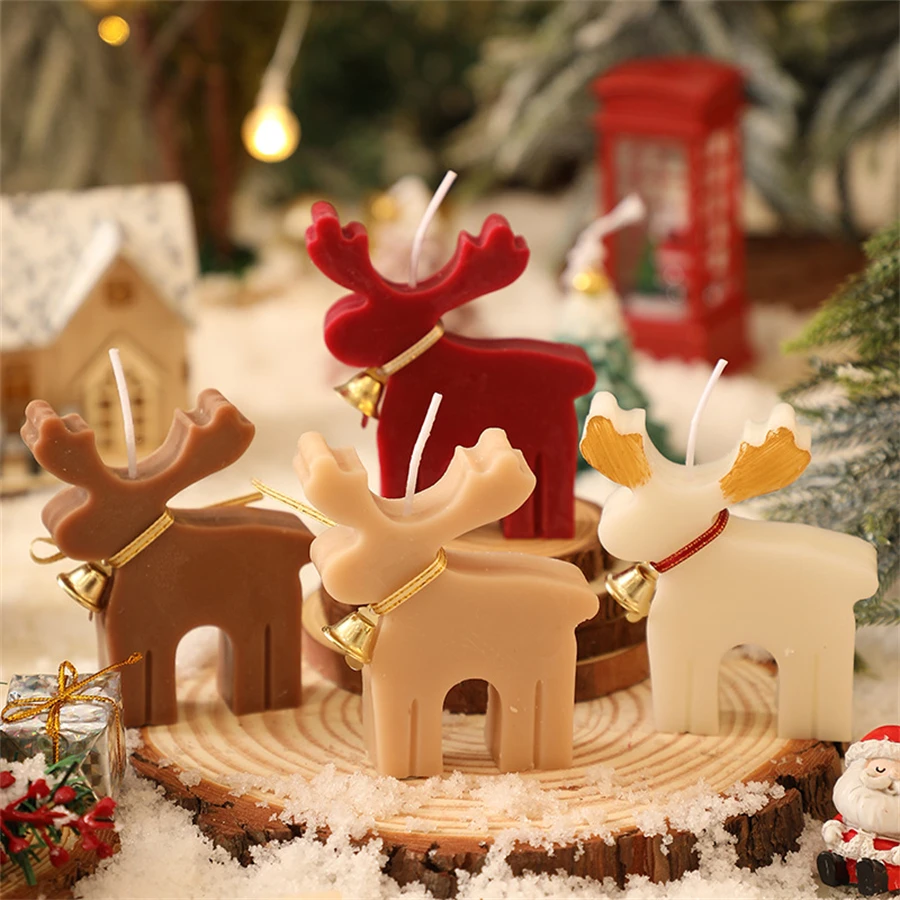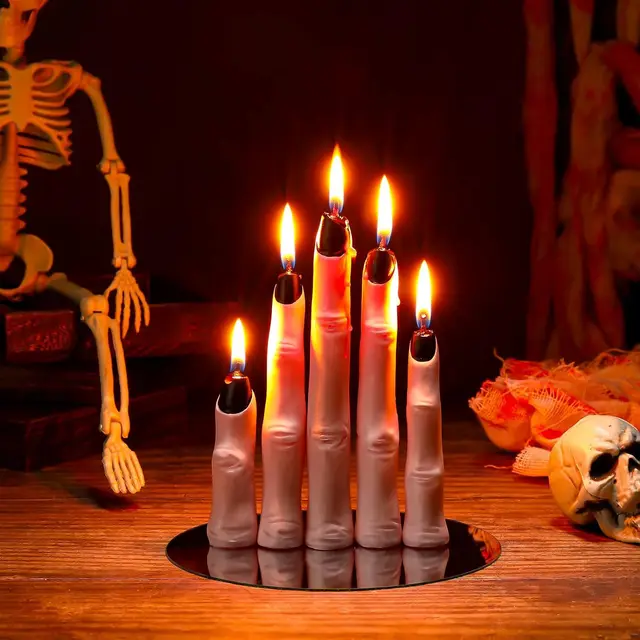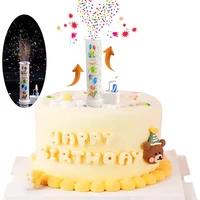Getting Started: How to Make Your First Handmade Candle Using Silicone Moulds
For beginners, the most healing moment of making handmade candles is watching the melted wax solidify into shape in the mold and finally demold it easily. Silicone molds have become the best choice for beginners due to their advantages of "non-stick, easy to use, and diverse shapes". Today, we will guide you through 5 simple steps to make your own handmade candle from scratch. We will also recommend suitable tools and materials throughout the process—follow along, and even beginners can succeed on the first try!
I. Prepare Tools: Choose the Right Materials for Higher Success Rate
The core of candle making for beginners is "simple tools and suitable materials". No complex equipment is needed—you can get all the following basic sets in one stop at our store:
- Core Mold: Recommend "Food-Grade Silicone Basic Mold" (round, square, or simple geometric styles are all acceptable; beginners should prioritize styles with smooth surfaces for easier demolding). The mold can withstand high temperatures up to 230℃, so it won't deform when pouring wax, and won't age even with repeated use.
- Wax Material: Priority is given to "Soy Wax Flakes". With a low melting point (about 50-55℃), it doesn't require high temperatures for melting, making it safer for beginners to operate. Soy wax has a fine texture and forms a smooth surface after solidification, which can perfectly replicate the mold's patterns. Mixing with 10% beeswax (you can choose the "Soy Wax + Beeswax Combo Pack") can increase the candle's hardness and prevent deformation after demolding.
- Fragrance/Oil: Choose "Plant-Extracted Aromatherapy Essential Oils" (such as lavender, citrus, cedarwood scents). With moderate concentration (10ml can be matched with 500g of wax), the fragrance is natural and not pungent when burning. Beginners are advised to start with "single-scent" oils and try mixed scents after getting familiar with the process.
- Other Tools: "Metal Melting Pot" (with a handle, can be directly heated over water in a small pot), "Thermometer" (to monitor wax temperature and avoid overheating that damages the fragrance), "Cotton Wick + Wick Holder" (cut the wick to be 2-3cm taller than the mold; the holder prevents the wick from tilting), "Stirring Stick" (wooden or silicone material to avoid scratching the mold), "Dropper" (to accurately control the amount of fragrance oil).
II. Step 1: Melt the Wax—Temperature Control is Key
- Weigh the Wax: Determine the amount of wax needed based on the mold size (for example, a cylindrical mold with a diameter of 8cm and height of 10cm requires about 150-200g of soy wax). Weigh it with a kitchen scale and pour it into the metal melting pot.
✅ Beginner Tip: The volume of wax will shrink slightly after solidification. It is recommended to prepare 10% more than the estimated amount to avoid insufficient height after pouring into the mold.
- Melt with Water Bath: Prepare a small pot, pour in about 3cm of hot water (water temperature not exceeding 60℃), place the melting pot with wax into the hot water, heat over low heat, and stir slowly with a stirring stick at the same time to melt the wax evenly.
- Monitor Temperature: Insert the thermometer into the wax. When the temperature rises to 60-65℃, the wax will completely melt into a transparent liquid. At this point, turn off the heat immediately, take the melting pot out of the hot water, and place it on a heat-insulating pad to cool.
⚠️ Pitfall Warning: Never let the wax temperature exceed 70℃! Excessively high temperatures will damage the fragrance of the essential oil and may cause the silicone mold to age and deform (although our silicone molds are heat-resistant, long-term contact with high-temperature wax will shorten their service life).
III. Step 2: Add Fragrance Oil—Accurate Proportion Ensures Long-Lasting Scent
- Wait for Wax to Cool: Let the melted wax cool naturally to 50-55℃ (monitor with a thermometer; the outer wall of the melting pot should feel slightly hot but not scalding when touched by hand). Adding fragrance oil at this temperature ensures the most long-lasting scent.
- Add Fragrance and Stir: Follow the ratio of "10ml of fragrance oil for 500g of wax" (beginners can appropriately reduce it to 8ml to avoid overly strong scent). Use a dropper to add the fragrance oil to the wax, then stir clockwise slowly with a stirring stick for 1-2 minutes to ensure the fragrance oil and wax are completely mixed without stratification.
✅ Product Adaptation: If you use our store's "500g Soy Wax + 10ml Essential Oil Set", you can add it directly according to the set ratio without additional calculation, making it more convenient for beginners.
- Let Stand to Remove Bubbles: After stirring, let the wax stand for 30 seconds to allow small bubbles on the surface to dissipate naturally. If there are many bubbles, gently pop them with a toothpick (act gently to avoid creating new bubbles).
IV. Step 3: Pour into the Mold—Fix the Wick to Avoid Tilting
- Pretreat the Mold: Clean the silicone mold, wipe it dry with a dry cloth (ensure no moisture, otherwise bubbles will form in the wax), and place it flat on a stable tabletop (you can place a paper towel underneath to prevent wax from soiling the table if it overflows).
- Fix the Wick: Pass the cotton wick through the wick holder, then clamp the holder on the edge of the mold's top. Adjust the wick's position to keep it in the center of the mold (you can gently straighten the wick with your fingers to ensure it is vertical).
✅ Beginner Tip: If the mold has no obvious edge, stick 2 small pieces of tape on the top of the mold and glue the wick holder to the tape. This can also prevent tilting (our "Wick Fixing Set" includes various fixing accessories suitable for molds of different shapes).
- Pour Wax Slowly: Hold the mold steady with one hand, and slowly pour the wax (cooled to about 50℃) into the mold with the other hand, stopping when it is 1cm away from the top of the mold (to reserve space for shrinkage). Keep a steady speed while pouring to avoid the wax hitting the bottom of the mold and creating bubbles.
⚠️ Pitfall Warning: If bubbles are found on the surface after pouring, gently draw a circle with a toothpick immediately—bubbles will float to the surface and burst. If the mold has a complex shape (such as an embossed style), tilt the mold slightly when pouring to let the wax flow along the inner wall of the mold, avoiding bubbles in the patterned areas.
V. Step 4: Wait for Solidification—Be Patient, Avoid "Early Demolding"
- Cool and Solidify Naturally: Place the mold with wax in a well-ventilated place, avoid direct sunlight and wind, and let it cool naturally. The solidification time of soy wax is about 2-3 hours (depending on the ambient temperature; it can be extended to 4 hours in winter).
✅ How to Judge Solidification: Gently touch the outer wall of the mold. If it is completely cold, and the wax surface has no depression or stickiness, it means it has fully solidified.
- Trim the Wick: After the candle is fully solidified, use scissors to trim the wick exposed above the mold to 1-1.5cm (too long will cause the flame to be too high when burning, while too short will make it difficult to light).
⚠️ Pitfall Warning: Never put it in the refrigerator to speed up solidification! Excessive temperature difference may cause cracks on the candle surface and damage the mold due to thermal expansion and contraction (our silicone molds are flexible, but sudden cold and heat will affect their service life).
VI. Step 5: Demold—The "Highlight Moment" of Silicone Molds
This is the most rewarding step for beginners! The flexibility of silicone molds makes demolding extremely easy—no release agent is needed:
- Loosen the Mold Edge: Gently pinch the edge of the mold with your hands, press inward and stretch slowly to create a small gap between the mold and the candle. The entry of air will reduce adhesion.
- Demold Gradually: Start from the bottom of the mold, fold it upward slowly (like taking off socks), and gently push the bottom of the candle with your fingers while folding. As the mold folds, the candle will gradually "slide out" of the mold.
✅ Adaptation Advantage: Our silicone molds are made of "high-elastic food-grade silicone". They can return to their original shape instantly after folding. Even for molds with complex patterns (such as "Flower Embossed Mold" or "Geometric Combination Mold"), demolding is easy without damaging the candle's shape.
- Touch Up Details: If there are a small amount of wax crumbs on the candle edge after demolding, gently wipe them off with a clean cloth. Small bubbles on the surface (a common issue for beginners) can be ignored as they do not affect use—they will decrease as you gain more experience.
VII. Beginner's Advancement: 3 Tips to Enhance the Candle's Appearance
- Add Decorations: After pouring the wax into the mold but before it is fully solidified (about 20 minutes after pouring, when a thin crust forms on the surface), you can put dried flowers (such as eucalyptus leaves, small daisies), dried lemon slices, or a small amount of glitter to create a high-value "Instagram-style" candle (match with our "Dried Flower Decoration Set" so you don't need to prepare materials yourself).
- Layered Color Blocking: Melt wax of different

Related posts
A 2-Year Candle Maker’s Honest Pick: 3 No-Regrets Bundles – Beginners & Pros, Listen Up!
Why Choose Our Candle Website Over Other E-Commerce Platforms?
Sustainable Holiday Celebrations: How to Host an Eco-Conscious Candlelit Dinner
The Candle from Longevity Village: A Small Ritual for Calmer, Fuller Days
Must-Haves for This Autumn: 5 Warm Spiced Candles to Ignite Your Cozy Season
Getting Started: How to Make Your First Handmade Candle Using Silicone Moulds
5 Stunning Geometric Candle DIY Tutorials: Unlock “Cool Aesthetics” with Moulds
Recent Posts
Recent Comments
Types
Hot Products
-
1Pcs Macaron Scented Candle Wax Aromatherapy Handmade Candles for Desktop Birthday Cake Decoration Photo Prop Festival Gifts
$16.86Original price was: $16.86.$12.65Current price is: $12.65. -
Mini Halloween Miniature Figurine Spider Bat Candle Skull Cartoon Scary Rabbit Statue Resin Fairy Garden Desktop Knick-knack $9.92 – $9.98Price range: $9.92 through $9.98
-
Complete DIY Candle Kit Aromatic Candles Making Tool Set Sticker Stainless Steel Wax Melting Pot Candle Making Supplies $3.49 – $6.86Price range: $3.49 through $6.86
-
Christmas Scented Candle Creative Mini Gloves Candle Ornaments Christmas Candles For Home New Year Table Decoration Gift $9.18 – $43.14Price range: $9.18 through $43.14
-
3D Skull Candle Silicone Mold DIY Halloween Decorative Candle Handmade Soap Plaster Epoxy Craft Casting Tools for Home Gifts $3.51 – $3.71Price range: $3.51 through $3.71
-
Halloween Horror Finger Candle Novelty Horror Horror Witch Thumb Candle Indoor Ambiance Scene Layout Decoration Props
$7.83Original price was: $7.83.$5.87Current price is: $5.87.
































